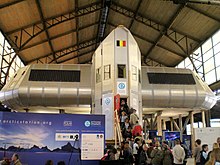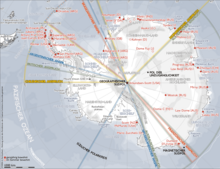Princess Elisabeth Station
Coordinates: 71 ° 57 ′ 0 ″ S , 23 ° 20 ′ 0 ″ E

The Princess Elisabeth Station is a Belgian polar research station that was set up during the International Polar Year 2007-2008 in the hinterland of the Princess Ragnhild Coast in Queen Maud Land , Antarctica . The “Princess Elisabeth” station is supplied with energy exclusively by solar and wind power. It is the first energy self-sufficient zero-emission research station in Antarctica. It was inaugurated on February 15, 2009.
Origin of the project
After almost forty years without direct Belgian participation in polar research in the Antarctic, it was decided, on the initiative of the International Polar Foundation (IPF) and with the support of the Fondation Roi Baudouin , to mark the fiftieth anniversary of the opening of the first Belgian polar station Base Antarctique Roi Baudouin in the Antarctic to build a new Belgian polar scientific research station.
location
The rocky terrain on which the station was built is located at an altitude of 1,400 m above sea level 180 km from the coast, in an area claimed by Norway between the Japanese Shōwa station (Syôwa) and the Russian station Novolasarewskaja , the 1500 km apart.
financing
The cost of building the station will be 6.4 million euros , of which two million euros will be borne by the Belgian government, the remaining 4.4 million euros will be taken over by private sponsors and financed by donations.
The Belgian Ministry of Science Policy has allocated three million euros to the research programs for 2008 and 2009 and has committed six million euros in funding for the period from 2006 to 2010.
construction
The aerodynamically designed building of the station is to eighty percent of wood, for the outer walls were laminated timber -Paneele used from spruce wood, in between a forty centimeters thick layer of is foam polystyrene and graphite disposed for thermal insulation. The wooden panels are connected by squared timbers made of beech wood.
Solar cells on the walls and on the roof of the station and eight wind turbines ensure the power supply. A diesel generator is available for emergencies. The heat radiation from the building services and the crew is regained. Three quarters of the wastewater is recycled.
Twelve researchers will carry out research in various areas in the station on a usable area of 700 m², including meteorology , glaciology , research on geomagnetism , research on microbiology and studies on the subject of " climate change ".
The Princess Elisabeth Station is designed for a service life of 25 years, which is almost twice as long as other stations.
The station was named after Crown Princess Elisabeth of Belgium , the daughter of the Belgian King Philippe and his wife Mathilde , who was born on October 25, 2001 .
Web links
- Belgian Antarctic Research Station - Princess Elisabeth Station
- Belgian polar platform
- COMNAP Antarctic Facilities ( Memento of August 7, 2011 in the Internet Archive ) (English)
- COMNAP Antarctic Facilities Map (English)
Individual evidence
- ^ Belga, AFP, Christian du Brulle (February 15, 2009). La station Princess Elisabeth inaugurée Le Soir (accessed February 16, 2009)

